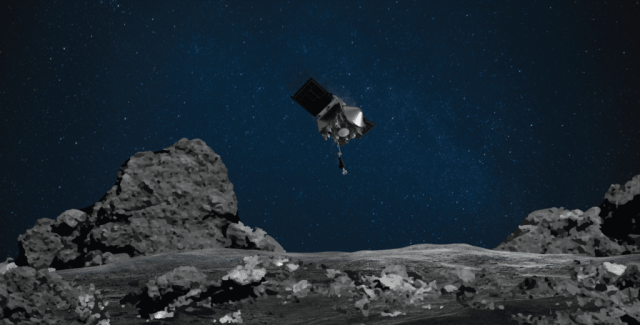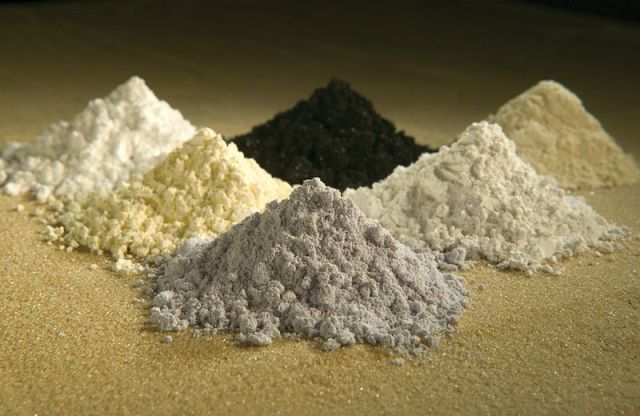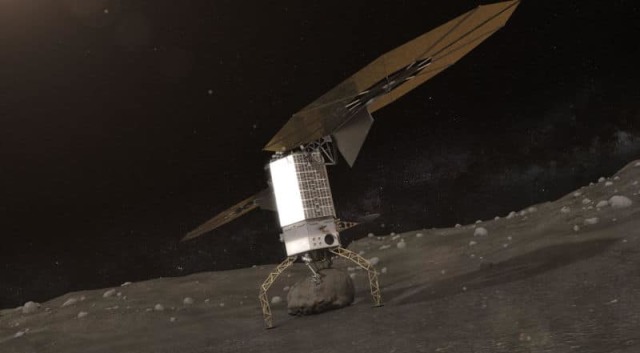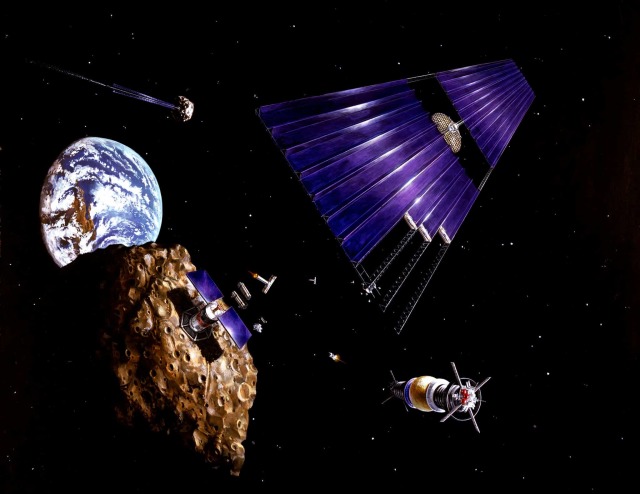The Earth's resources are limited, and questions about where to get them in the future are already arising now. The most suitable answer to the growing demands of man seems to be space with its vast expanses and asteroids stuffed with rare metals. But who and how plans to mine ores on "space cobblestones"? And most importantly, is it even real? Naked Science reflects on the cultural heritage, present and future of commercial asteroid exploration.
The idea is not yesterday's
From the very beginning of its history, man could not help noticing activity in the heavens: in addition to the movement of planets, comets flew past the Earth, asteroids pierced its atmosphere. According to the celestial activity, they tried to make predictions and searched for meaning for each event: what is worth at least the idea of the star of Bethlehem, which, as it was believed, announced to the Magi the birth of the King of Judea. The same applied to meteor bodies, from meteors to asteroids, the appearance of which in the night sky could indicate certain important upcoming events. Now it seems a little ridiculous, but it's not worth writing off meteorite falls altogether. Of course, it is wrong to put an equal sign between their appearance and a conditional solar eclipse, but at the same time, "heavenly stones" did not just declare their existence, but often directly influenced a person's life.
For example, it was the fall of a meteorite, according to a recent study, that could become the basis of the plot about the destruction of Sodom and Gomorrah. Another vivid example of the "asteroid" influence on the world is metals. As scientists have established, the dagger found in the tomb of Pharaoh Tutankhamun (lived in the XIV century BC) was forged just with the use of metal that fell to Earth when a meteorite fell. In other words, the suitability of the resources that asteroids conceal is a truth that has been proven for millennia, and the idea of getting to these resources is also not as new as it may seem.
One of the first mentions of the prospect of extracting metals directly from a celestial body dates back to the second quarter of the last century — when the story "Golden Asteroid" by the famous science fiction writer Clifford Simak was published. The story of space prospectors who found an asteroid with a high gold content, which caused a collision with a space pirate, became one of the first excursions into the topic of space prospecting in history, and over the following years it has developed rapidly. From Isaac Asimov's "Catch That Rabbit" and Robert Heinlein's "Rolling Stones" to Daniel Suarez's Delta-V (released in 2019), the asteroid mining theme has not let go of the minds of science fiction writers and continues to inspire people from a variety of entertainment-related industries.

An iron dagger from the tomb of Tutankhamun, found between the bandages of the mummy on the king's right thigh, is on display at the Egyptian Museum in Cairo (Egypt)Image source: Olaf Tausch
These are not only films like Armageddon or The Expanse series, but also video games. What is only the representation of mining in the Elite Dangerous space simulator, the ability to sell asteroids in "Space Rangers" and other projects. And this is not to mention the horror Dead Space, all the action of which takes place on a ship specializing in mining.
However, if in books, games or movies it takes minutes to "crumble" an asteroid, then in the real world this is still a problem. But even the theoretical possibility of coping with them does not allow hundreds of people around the world to sleep peacefully.
The anatomy of space mining
In order to understand how a particular asteroid can be attractive, it is necessary to determine what a person can extract from it. And here scientists have already made significant progress, having learned to navigate the abundance of celestial bodies waiting for us in space. They are divided into three types: carbonaceous asteroids of class C, silicate or silicon asteroids of class S and metallic asteroids of class M. The first two types occupy 90 percent of the total number of asteroids, but they are of little interest for mining. Metallic asteroids are only the remaining 10 percent, but they are of serious primary interest. These celestial bodies may have once been the metallic cores of large cosmic bodies destroyed as a result of the formation of a star system.
The solar system (from the Sun to Jupiter). It includes the asteroid belt (a white ring-shaped cloud), the Hilda asteroid group (an orange "triangle" right inside Jupiter's orbit) and asteroids in Jupiter's orbit (green). The group of celestial bodies that is ahead of Jupiter is called the "Greeks", and the closing group is called the "Trojans"Image source: Skab, NASA
On such asteroids, platinum, ruthenium, palladium, osmium are in abundance — rare metals on Earth attract the minds of not so much scientists as businessmen who expect to extract fabulous profits.
And there are exactly two good news for such enterprising people. The first is that, for example, the asteroid 2011 UW158 is "estimated" at about five trillion dollars, and the second is to get part of the asteroid and return to Earth really now.
So, in 2010, the Japanese Hayabusa spacecraft successfully delivered rock samples from the asteroid Itokawa to Earth, and in 2020 Hayabusa-2 returned with samples from the asteroid Ryugu — yes, so far it has brought only five grams, but it's a bad start, and if not the development of space resources, then at least their exploration it's already started. In 2023, by the way, the American OSIRIS-REx is supposed to deliver samples from the asteroid Bennu, and in the same year a NASA mission to the asteroid Psyche is planned — also to extract samples and deliver them to Earth.
The mentioned missions are scientific initiatives, during which, nevertheless, some technologies that will be needed later will be tested; in addition, they will popularize the very idea of asteroid exploration. And business does not just connect, but does it actively: however, the first companies intending to engage in mining on asteroids have already closed.

Landing of an Earth vehicle on an asteroidImage source: University of Arizona, Goddard, NASA
These are American Planetary Resources and Deep Space Industries, who promised to start developing space resources: as with scientific expeditions, all projects involve the use of robots. But Planetary Resources and Deep Space Industries failed to attract investors to their projects: the nascent industry has already managed to give birth to its own mini-bubble, scaring off some overly optimistic entrepreneurs.
New generation companies, such as Asteroid Mining Corporation, are actively looking for partners. The startup AstroForge even succeeded: last year it attracted $ 13 million in investments. Such a flow, even despite the sad experience of the first wave of mining companies, we can explain: after all, according to Goldman Sachs, it is this industry that can give the world the first trillionaires.
But where there is money, there are always problems, and the story of asteroid mining will not be an exception.
Big space — big problems
The first controversial point in space mining is sewn into the very essence of mining metals that are extremely rare on Earth. For example, if the scenario of the already mentioned "Golden Asteroid" Saimak became a reality, such mining would have a radical effect on metal prices, and it's not only about the fall in shares of "terrestrial" gold miners, but about the collapse of the entire system related to gold: from jewelry to gold and foreign exchange reserves and electronics. The same will apply to other metals, which are extremely problematic to find on Earth.

Earthlings are now experiencing a great shortage of rare earth metals, they are required in many areas of industry. In particular, these rare earth oxides are used as indicators to determine which parts of the watershed are being eroded. Clockwise from the center at the top: praseodymium, cerium, lanthanum, neodymium, samarium and gadoliniumImage Source: Peggy Greb, USDA
Moreover, political risks should also be expected here. For example, today China supplies about 85 percent of the total mass of rare earth metals to the world market and can use its dominant position as an argument in trade wars or international conflicts. It is difficult to imagine what will happen to such a position when the world is flooded with space "rare earths", but the fact that a new industry can create new points of tension is undeniable.
The ambiguous international status of the extracted metals can also aggravate this tension. Today, the main document regulating space from a legal point of view is the so—called 1967 Outer space Treaty . It states that "outer space, including the Moon and other celestial bodies, is not subject to national appropriation either by proclaiming sovereignty on them, or by use or occupation, or by any other means," this formulation most closely relates to the topic of mining. It follows from it that no one can appropriate the celestial bodies themselves, but not a word is said about their bowels and resources.
And this ambiguity is already making itself felt: the Russian Foreign Ministry proposes to the world community to develop an international legal mechanism for the extraction and use of extraterrestrial resources. At the same time, the United States and, oddly enough, Luxembourg have already officially adopted laws allowing their companies to extract and appropriate the extracted "space" resources. Such initiatives, as Roscosmos reasonably noted, compromise international space law.
At the same time, it is not difficult to guess that if the scenario of the USA or Luxembourg attracts more and more countries, then at least the nervousness caused by the division of asteroids, satellites and planets can undermine not just the industry, but all the mechanisms and norms of international law regarding space.
And if economic risks can still be resolved, for example, by strictly regulating the mass of metals imported to the Earth and encouraging the creation of a separate production and business infrastructure from the Earth, then it will be increasingly difficult to find consensus on policy.

A project of a robotic arm with micro-spikes at the ends of the "toe-fingers" for grabbing and securing a boulder from a large asteroid. As soon as the boulder is firmly grasped, the "legs" will push off and provide an initial lift without the use of rocket boostersImage Source: NASA
The very prospect of mining is real, and the problems here are not so much technical in nature as political and economic. If humanity manages to overcome differences (including, for example, on other resources, such as water at the poles of the planets closest to Earth, which will certainly be needed during colonization), then mining will become the basis of progress. In any of the scenarios, colonization of even the nearest planets is impossible without using the resources offered by the Universe, and mining will inevitably become one of the main industries that ensure this process. But no one knows yet how many bankrupt companies, test trials and rounds of negotiations the world will see before an autonomous machine extracts the first ounce of platinum from an asteroid.

